

New car prices may still be climbing, but they can only go so high before auto lenders begin to balk. That may happen sooner than you think, as climbing interest rates, later payments, and rising repossessions may indicate a downturn for car financing—and possibly the automotive industry as a whole.
Interest rates are on the rise according to multiple sources, with Cox Automotive observing an increase from an average of 5.15 percent in December 2021 to 8.02 percent in December 2022. This is corroborated by a TransUnion report that noted monthly payments increasing in Q4 2022, as well as Edmunds, which reports APR on new car loans averaged 6.92 percent in January. For used vehicles, they averaged an even higher 10.57 percent APR. In August, those numbers reportedly sat at just 5.7 and 9.0 percent.
This in turn means that more and more Americans are paying over $1,000 monthly for their vehicles. It’s particularly common in Wyoming, where more than a quarter of borrowers pay that much per month, and Texas, where that fraction’s just over a fifth.

Rising monthly payments coincide with an increasing number of borrowers falling behind on their payments. According to TransUnion, the volume of borrowers more than 60 days behind on their auto loans in Q3 and Q4 2022 crept up by 0.13 percent—nearly double the seasonal average of 0.07—to 1.78 percent. The most notable hike concerns subprime borrowers, 5.67 percent of whom were two months behind on their payments according to Fitch Ratings, per Bloomberg. That’s up from just 2.58 percent in April 2021, and above the 5.09 percent high reached in January 2009.
Repossessions also grew by 11 percent over 2021 according to Manheim per Bloomberg—though they’re still 26 percent below their peak in 2019.

While new car prices show signs of slipping, with Ford CEO Jim Farley forecasting a five-percent decrease in transaction price in 2023, auto financing is falling off. TransUnion says the amount financed for auto loans is decreasing, and that loan originations (or new loans) in Q3 2022 were at their lowest since 2013. Leasing is down sharply too, from 24.7 percent of vehicle registrations in Q4 2021 to 20.9 that quarter in 2022.
It’s unclear whether these trends amount to problems on their own, but past economic downturns indicate how things could play out for the auto industry from here. Recessions have historically made lenders more cautious, dragging down industries that depend on borrowed purchasing power—like the automotive industry. It’s hard to say for sure if auto loans are about to slow to a trickle, but if they are, it couldn’t happen at a worse time for an industry that’s struggling to electrify, all while grappling with continued supply chain problems. Regardless, it’s gonna be a bumpy ride.
Got a tip or question for the author? You can reach them here: james@thedrive.com